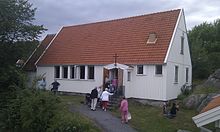Brännö
| Brännö | ||||
|
||||
| State : | Sweden | |||
| Province (län): | Västra Götalands län | |||
| Historical Province (landskap): | Västergötland | |||
| Municipality : | Gothenburg | |||
| Coordinates : | 57 ° 39 ' N , 11 ° 47' E | |||
| SCB code : | 4322 | |||
| Status: | Crime scene | |||
| Residents : | 918 (December 31, 2015) | |||
| Area : | 1.93 km² | |||
| Population density : | 476 inhabitants / km² | |||
| List of perpetrators in Västra Götaland County | ||||
Brännö is an island and a place ( Tatort ) in the Swedish province of Västra Götalands län and the historic province of Västergötland in the municipality of Gothenburg . The island is located in the Kattegat in the southern part of the Gothenburg archipelago west of Gothenburg .
location
The population of the island is around 900 people (2015), but increases in summer to up to 3000 people due to holidaymakers.
The island has two boat docks. Rödsten on the east side of the island is the more heavily used. The Husvik jetty is on the west side of Brännös . There is a ferry connection to Saltholmen on the mainland. The landing stages are connected by a two-kilometer paved path. As on the neighboring archipelago, there is no private vehicle traffic on Brännö. West of Brännö is the uninhabited island of Galterö , which can be reached via a small bridge and which serves as pasture for Brännö's sheep. To the east are the islands of Rivö and Asperö . Brännö reaches an extension of about three kilometers in north-south direction and about two kilometers in west-east direction.
Unlike the neighboring islands, Brännö has fertile soil, which makes agriculture possible. In addition, there are forests, meadows and granite cliffs. Martens , hedgehogs and hares can be found on Brännö . The highest point is 45 meters.
history
Brännö was already settled in prehistoric times. Tools and remains of two settlements from around 7,000 BC were found on Brännö. Brännö became more important in the Viking Age . Around the year 1000, the Brännoarna trading post existed here . The Jordebok King Valdemars mentioned the island as Brænnø in the 13th century. The name Brännös is said to go back to the meaning of surf .
Since Brännö is located immediately south of the route to the port of Gothenburg further east, the island was of strategic importance. Until the 18th century, Brännö was repeatedly attacked by Danish troops. Agriculture was practiced on Brännö. In addition, the residents also worked as pilots and customs officers . The fishing played only a minor role.
In the 1920s, pilot villas were built near the Husvik jetty in particular. From the 1930s on, holiday homes developed in Gothenburg.
Sights and events
The town center consists of listed houses from the 18th and 19th centuries. There has been a local museum in Brännö since 2004.
In the summer months there are dance events on Thursdays at the Husvik jetty to the music of the composer Lasse Dahlquist , who lived on Brännö and died here.
Economy and institutions
In Brännö there is a food retailer Brännö Handel as well as restaurants with the Brännö Värdshus and the Bryggcafé . In addition, there are smaller accommodation establishments. About one kilometer north of Rödsten is the Gröna Vik bay, which is used as a bathing area . Lotsutkiken is a lookout point on the island .
Personalities
The Swedish composer, writer, singer and actor Lasse Dahlquist lived on Brännö and died here in 1979. He was buried in the cemetery next to the church.
The German painter Otto Strützel (1855–1930) went on his honeymoon to Brännö after his wedding in 1886.
literature
- Lars Dörenmeier, CityTrip Göteborg , Reise know-how Verlag Peter Rump GmbH, Bielefeld 2012, ISBN 978-3-8317-2145-0 , page 77 f.




